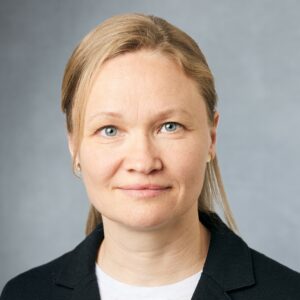Business Cycle and Growth
Growth research deals with the question which factors influence the long-term development of countries. Business cycle research, on the other hand, attempts to understand the causes of short- to medium-term deviations from the long-term growth trend and to forecast the likely further development in the short-run (typically 1-2 years).

Traditionally, the gross domestic product (GDP), i.e. the sum of goods and services produced expressed in values, represents the central indicator of prosperity in economics. Economists have always been concerned with the question of which factors promote or inhibit economic growth in order to develop economic policies To be able to draw conclusions about how the long-term prosperity of economies can be secured or improved. In its research activities, the HWWI deals with the determinants of economic growth and explicitly includes further concepts of measuring social prosperity, such as life satisfaction, in its considerations.
Economies typically do not develop linearly along their long-term growth path. Rather, in all economies there are short- to medium-term fluctuations in economic activity to observe the growth path, the so-called business cycles. Economic fluctuations are often associated with frictions such as unemployment and inflation and create an inefficient use of economic resources. In today’s highly globalized world with complex international supply chains, there is a strong international economic context. Because of the strong international interdependence of financial, raw material and goods markets, this connection is particularly pronounced in times of financial crises, wars or pandemics. The HWWI researches the international economic context and analyzes its likely consequences for the German economy. In this context, the HWWI regularly forecasts the German economic development and also prepares a regional economic forecast for Hamburg. For this purpose, the HWWI uses the results of the quarterly economic survey of member companies provided by the Hamburg Chamber of Commerce. The survey data is also used to analyze the development of individual industries or types of companies. The HWWI pays particular attention to medium-sized companies where ownership and management lie in one hand.
As part of its economic and growth research, the HWWI also deals intensively with the development of the prices of a wide range of raw materials. The focus of the analyzes is the HWWI raw material price index, in which the world market prices of the most important products from all sub-segments of raw materials trading are recorded and condensed into a meaningful index using an objective weighting methodology. The weekly recalculation based on the latest data ensures that the information is up-to-date and generates high-frequency time series for differentiated trend and volatility analyses.
Employees
Publications


Events

HWWI at the annual conference of the Verein für Socialpolitik in Berlin

Striking evidence: The impact of railway strikes on competition from intercity bus services in Germany
Prof. Dr. Alexander Sandkamp

Extreme weather shocks, economic resilience, and the role of local financial structure
Vinzenz Peters, M.Sc.

Press Releases

New HWWI Forecast
The German economy stagnated overall in the 1st half of 2025; German gross domestic product fell by 0.3% in the second quarter, as it had risen in the first quarter. Special effects (bringing forward production and exports to the first quarter due to expected US tariffs and mild winter weather) played a role in this, and the new government only took up its work in May and the economy initially waited for its reform plans. After the coalition parties had already greatly expanded the debt possibilities for the infrastructure and defence sectors before the government took office, it has now also introduced the first measures to improve the location conditions. This should ease the previous reluctance of investors and provide growth impetus in the future. Private consumption has been supporting the economy for some time. However, further dampening influences come from the export side, because despite the “tariff deal” with the USA, tariffs on US exports are now higher than in the pre-Trump era. Overall, however, the positive impulses will outweigh the negative impulses in the future, so that a gradual revival of the economy is to be expected for the rest of this year, which will then continue to intensify next year. The HWWI continues to expect economic growth of 1/4 % on average for 2025 and 1 1/2 % for 2026.

New HWWI-Forecast
The German economy grew surprisingly significantly in the first quarter of this year, by 0.4%. As some one-off effects favoured this development, the second quarter is likely to be weaker. In the meantime, a new government is in office. The Union had announced comprehensive economic reforms. However, it remains to be seen to what extent the necessary measures to improve the location conditions can be implemented in the coalition with the SPD in view of partly different economic policy ideas. With clear reform decisions, the previous reluctance, especially among investors, is likely to dwindle. The new coalition government has also greatly expanded the debt possibilities for the infrastructure and defense sectors even before taking office. This will provide economic stimulus in the future. In the short term, however, there are still dampening influences. In addition to the geopolitical uncertainties, there is the unpredictable trade policy of the new US administration; tariffs have also been increased or introduced on German exports to the USA, and there is a threat of more. This reduces the economic revival expected for the rest of the year. For 2025, the HWWI expects real gross domestic product to grow by 0.2% on an annual average, not least because of the negative overhang from 2024. Assuming that the new government quickly implements important economic reforms, starts additional spending on infrastructure and defense, and further monetary easing, economic growth of 1 1/2% is possible for 2026.

HWWI-Commodity Price Index Continues Upward Trend
The HWWI-Commodity Price Index has recorded a significant increase in recent months, continuing its upward trend since October. In the three reporting months from November to January, the index rose by 1.3%, 1.4% and 4.9% respectively. In January, the index was therefore 14% higher than in the same month of the previous year (as of 5 February 2025).








